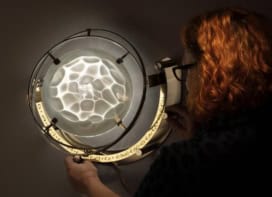Philippe Blondel reviews Sonic Wonderland: a Scientific Odyssey of Sound by Trevor Cox

Small waves lap the side of our boat, making relaxing sounds. Every now and then, the little icebergs melting around us add their clinking noises, while the larger bergs bump gently against the boat’s rubber tubes as we drift past a large glacier. When parts of the glacier’s front wall collapse, we all jump. The loud explosion is followed by a series of surface waves, gentle at first but carrying blocks of ice that weigh in excess of 50 tonnes. Underwater, the general hissing sound, interrupted by slapping from the waves and crackling from the ice, reaches high intensities as it echoes from the sides of the fjord.
The ocean off the coast of Svalbard, where I spent last summer measuring underwater noise, is definitely not the “silent world” of Jacques Cousteau fame. But this should not surprise us. Most of the world is, in fact, full of sound – sound that is always there for us to sense, if we can stop ourselves relying only on visual stimuli. Sonic Wonderland is the perfect reminder of this rich soundscape. Before being asked to review this book for Physics World, I had seen it in advertisements and decided that its price tag was a bit too high. Now, having read it, I wonder why I did not jump on it immediately, regardless of the price. What comes first out of this book is the sheer variety of acoustic processes, how mysterious and entrancing they can be, and how understanding the physics behind them adds another dimension to their enjoyment. Not only that, but reading it made me want to travel all over the world to discover the acoustic wonders that the author, Trevor Cox, explains so passionately and so well.
The book’s chapters logically go from the loudest to the quietest places on Earth, placing sound in its wider human or natural context. We learn about simple sounds and how they are distorted by their environment, from reverberation under bridges or in sewers to echoes and whispering galleries. Relevant examples are presented alongside interesting stories about how British birdsong nearly leaked war secrets to the Nazis during the Second World War; how unusual echoes in the castle at Chinon, France, can be used to make calumnious accusations; and how church bells could be heard far out at sea without the need for supernatural explanations. On a related note (pun unintended), the urban legend that playing music backwards leads to satanic indoctrination is safely laid to rest, as the author explains that this process produces only meaningless noise, regardless of what record is played.
In addition to these historical anecdotes, we also learn about acoustics in a range of different buildings, from the author’s house (and bathroom) to churches, mosques and concert halls around the world. We come to understand what makes a “good” sound and what can be done to avoid unwanted echoes and the hubbub usually associated with badly designed cafeterias. The sounds of instruments appear in several chapters, with sections on the saxophone, violins, brass and, of course, organs and bells – including the author’s first-hand account of experiencing Big Ben’s chimes from inside the tower.
Natural spaces have their own peculiar acoustics, and we learn about Stonehenge and other antique sites, as well as tidal bores, waterfalls and even simple bubbles. With clear diagrams (and sometimes the support of audio clips on the book’s accompanying website), Cox demystifies these natural noises, explaining how sands can “burp”, how rocks can “sing” and why city-dwelling birds need to sing louder or later to adapt to urban life. In most cases, he has gone to study these sounds himself – measuring them, analysing them, and beautifully reporting on how they work and what they mean. In my own recent holidays, I was lucky enough to hear the sound from stalagmites in French caves, and Cox’s presentation of the Great Stalactite Pipe Organ (including a very nice example on SoundCloud) shows how human ingenuity has made the most of these natural or near-natural sounds. Other examples of human-nature sonic collaborations include Blackpool’s High-Tide Organ, which uses natural tides to create eerie and surprising sounds, as well as sculptures in London and further afield. I also learned with interest that musical roads do not exist only in Jasper Fforde’s novels, and I now know where to experience them directly.
My speciality is underwater sounds, so as I was reading (and enjoying) the book, I was also on the lookout for items directly relevant to my own experiences. I was not disappointed. Bearded seals and snapping shrimps, loud ships and quiet submarines – they are all there, clearly presented and exactly as heard around the world’s oceans. The clinking of ice and the noise of small bubbles coming from the melting of icebergs were even illustrated with examples from Iceland and Svalbard, to which I could directly relate. By adding numbers to these measurements, Trevor Cox also reiterates the fact that decibels underwater are definitely not the same as decibels in air (because of the different reference levels). My conclusion is that while this book is primarily intended for a popular-science audience, there is enough to keep even field-hardened professionals firmly interested.
These few examples should make it clear that I loved this book. It is definitely worth the price, and even if it seems strange to read about sound instead of listening to it, Sonic Wonderland is the perfect arrangement. (It is also a great gift idea for the coming festive season.) Inspired by this book, I now listen to the rumbling of the bus, the noise of the city, and of course the birds and cows on my way home. More importantly, this book has given me new ideas of places to explore: I want to listen to the Severn Bore and to trees in the forest; I want to visit concert halls and go on soundwalks around my favourite cities. There is an entire world to explore, and it’s out there for us to listen to, and to enjoy.
- 2014 The Bodley Head £20.00hb 320pp


